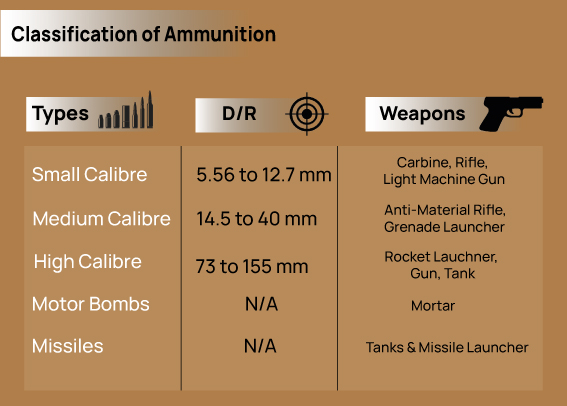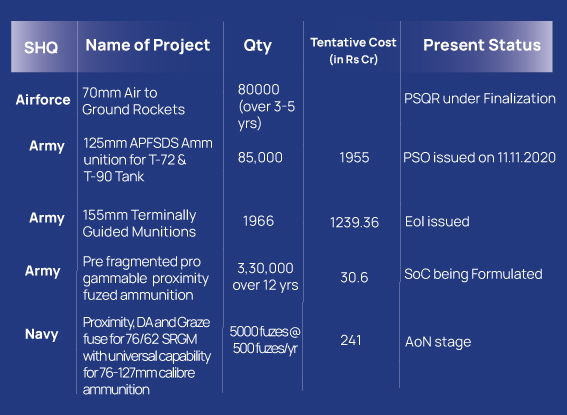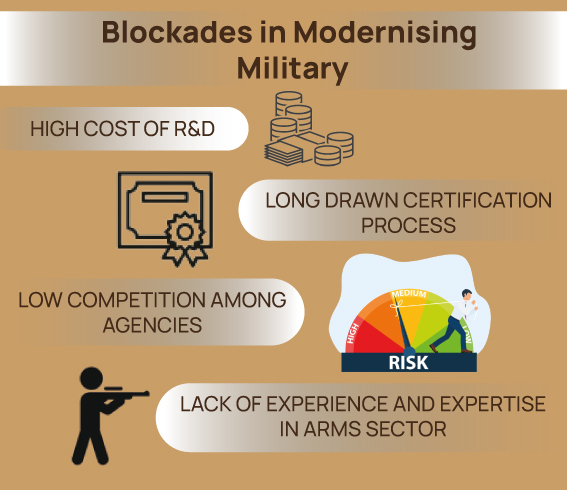The recent war in Ukraine has prompted many governments to develop a plan of action to secure their country’s defences in the event of a long-term war. This war is an example of how situations can escalate even in this modern day and age for which the countries need to be prepared. India is focusing on strengthening its line of defence by improving its arsenal. For this, the government has come up with the ‘Make-in-India’ and ‘Make-II’ initiatives.
“During the last couple of years, several key schemes were announced and implemented to kick-start the revival of the economy and boost the degree of ‘Atmanirbharta’ in our economic landscape, including in the defence sector. As a part of these initiatives, three positive indigenisation lists were announced. The first list of indigenization included 17 items related to ammunition and artillery,” says Arun Chawla, Director General FICCI.
Previously, only the ordinance factories and the public sector had the rights to manufacture ammunition. The Make-in-India initiative will allow private players to join the arms manufacturing race.

“The key to Atmanirbharta clearly lies in policy implementation. Though the Arms Rules, licensing & FDI policies and acquisition procedures have been revamped between 2016 and 2020 to incentivise the active participation of the private sector, the re-tendering of cases since 2017 has been a dampener,” says Lieutenant General, Sunil Srivastava, Director, CENJOWS.
Industrial licensing is required for manufacturing arms in the defence sector under the Industries Development and Regulation (IDR) Act, 1951. Since 2001, the government has allowed the Indian private sector to actively participate in the defence manufacturing sector subject to acquiring the licence for it under the IDR Act.
Make-in-India initiative- The MAKE scheme
The new Indian initiative to modernise the infantry is aimed at enhancing its lethality and for providing individual protection. To enable the Ordnance Factory Board’s (OFB) plan of production, a five-year roll-on indent was placed on them for ammunition management. The order was mutually agreed upon keeping in view the agreed targets and the Defence Public Sector Undertakings (DPSUs) capacity. The remaining set of ammunitions is procured by the army from the Indian private sector. The ministry of defence (MoD) has also identified several large calibre ammunitions that will be procured under the ‘Make-in-India’ category of acquisition.

“The other challenges are that of technology, modernisation and import dependence. The kinetic application of force will remain the decisive deterrent and war-winning factor for countries like India, beset with border disputes and conflicts since Independence, which defy an early resolution. Several specialised munitions like anti-tank, air-to-surface, air-to-air and surface-to-air, loitering, GPS guided artillery shells, rockets, MANPADS and grenades have been imported post-2016,” Srivastava points out.
The make scheme or Make-in-India scheme was first introduced in the initial version of the Defence Procurement Procedure (DPP). The government has since started focusing on indigenisation and has imposed an import embargo on defence equipment, while identifying new make programmes. This list will keep extending as more items are identified and added to the list.
Here is a list of the Make-II projects associated with ammunition:


Private players, their roles and opportunities
The role of the private sector has been increasing phenomenally since 2001, post-liberalisation. Continuous efforts are being made to achieve the goal of self-reliance and to increase indigenisation. The Indian private sector is working keenly after changes and amendments have been made in various policies. The Make-in-India vision is clearer than ever.
Let’s take a look at some of the key players in the private industry, their collaborations and their future plans:

Long standing problems and challenges ahead
The defence and ammunition sector is reeling under a major problem; the low rate of R&D. There has not been much R&D on the products that are imported. The core problem arises from the fact that the manufacturing of ammunition in India has always been totally under the government. It was only after 2001 and after some additional amendments in 2016, that the entry of private players in the arms manufacturing market was allowed.
“There is an urgent need for India to enhance its production capacity and R&D capability. The development of this sector will meet the current demand-supply gap in critical equipment and also go a long way in reducing our reliance on import. So, this area holds immense opportunities for the private sector,” Chawla points out.
Also Read: PM Modi: India to become Aatmanirbhar in defence manufacturing
The Indian ammunition ecosystem never really developed due to these shortcomings. The ecosystem that was in place predominantly produced only indigenised foreign products. Its success was marked by and depended on the reverse engineering of the foreign ammunition that was acquired and the gathering of knowledge in the long term.
The non-localisation of the complete supply chain of indigenised ammunition and the constraints that came with imported goods, the deterioration in quality, the high rate of failure and the destruction of large stocks and many other reasons led to the fall in confidence of the indigenous players in this arena.
The financial power to sanction import contracts were not in the hands of these players and they faced multiple delays and scrutiny due to the various sanctions imposed on them. Even after this, there were various other issues like the blacklisting of suppliers who were the single source of supply worldwide and the Original Equipment Manufacturers (OEMs) discontinuing the manufacturing of certain ammunition still under tendering contracts, etc.
The situation saw a little improvement after the amendments were made in 2016. Special provisions in 2017 helped to speed up the process of obtaining stocks from OEMs. Emergency procurement powers supported and gave relief to the sector as well. Also, new types of ammunition have been added to the Make-II category to promote and encourage R&D in the industry.

The modernisation of the forces depends mainly on how self-reliant India can become in terms of producing its own ammo. The challenges that India faces are:
- High R&D costs with the allocation of only six per cent of the total defence budget to this sector.
- India lacks the expertise for designing critical components for smart and precision munitions.
- India also doesn’t have the kind of infrastructure and human capital required to support R&D inventiveness. These factors point to the fact that there is near to no competition within the R&D firms.
- The certification or licensing part is also a hectic and long-winded process. There are only limited testing facilities for the private sector to test their prototypes for which too they have to wait for a long time.
Also Read: PM unveils ‘SPRINT challenges’ to promote indigenous tech in Indian navy
“The three positive lists, issued between 2020-2022, progressively preclude the import of a plethora of guided munitions, range extension kits, mines, course correcting fuzes, cruise, anti-ship and anti-radiation missiles and loitering munitions. With clear and firm requirements that are known for the next 10 years, the opportunity for both the private industry and for the invigorated DPSUs, is indeed unique and unprecedented,” Srivastava says.











